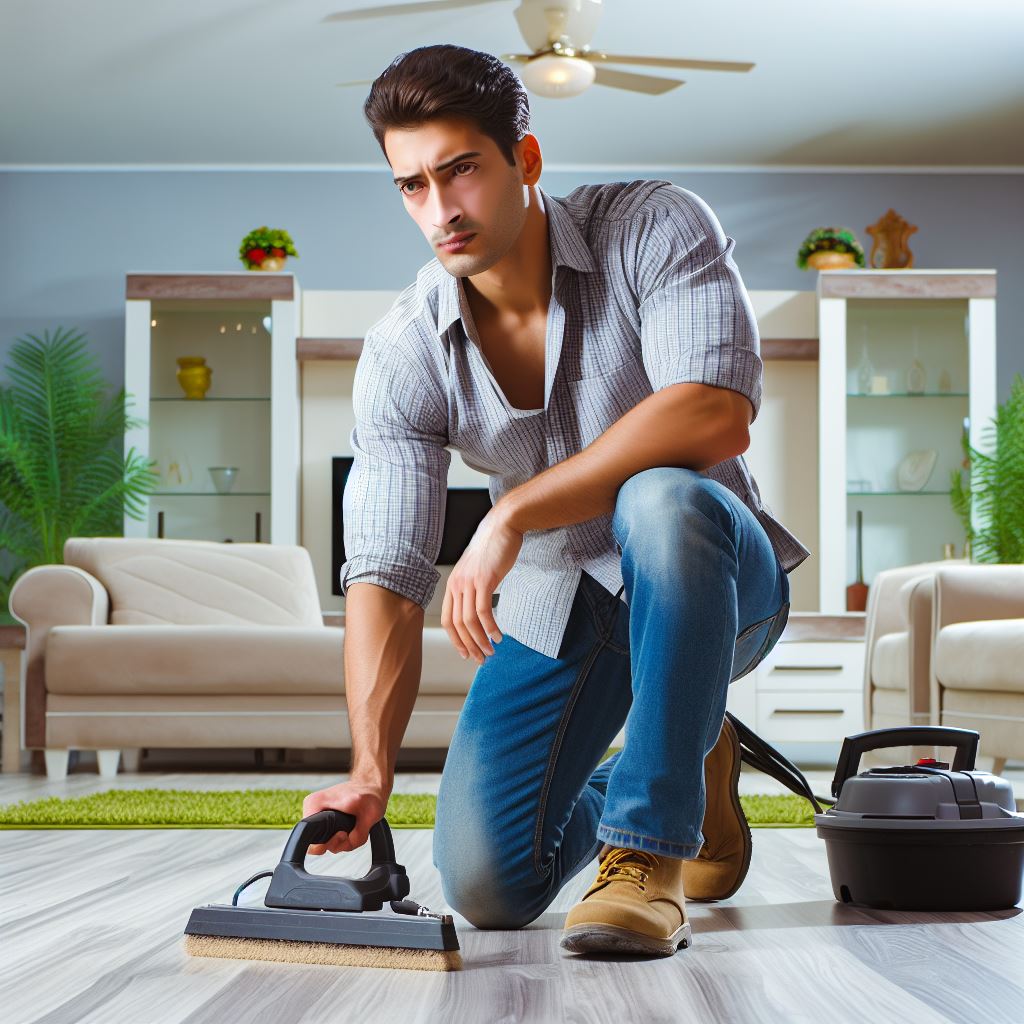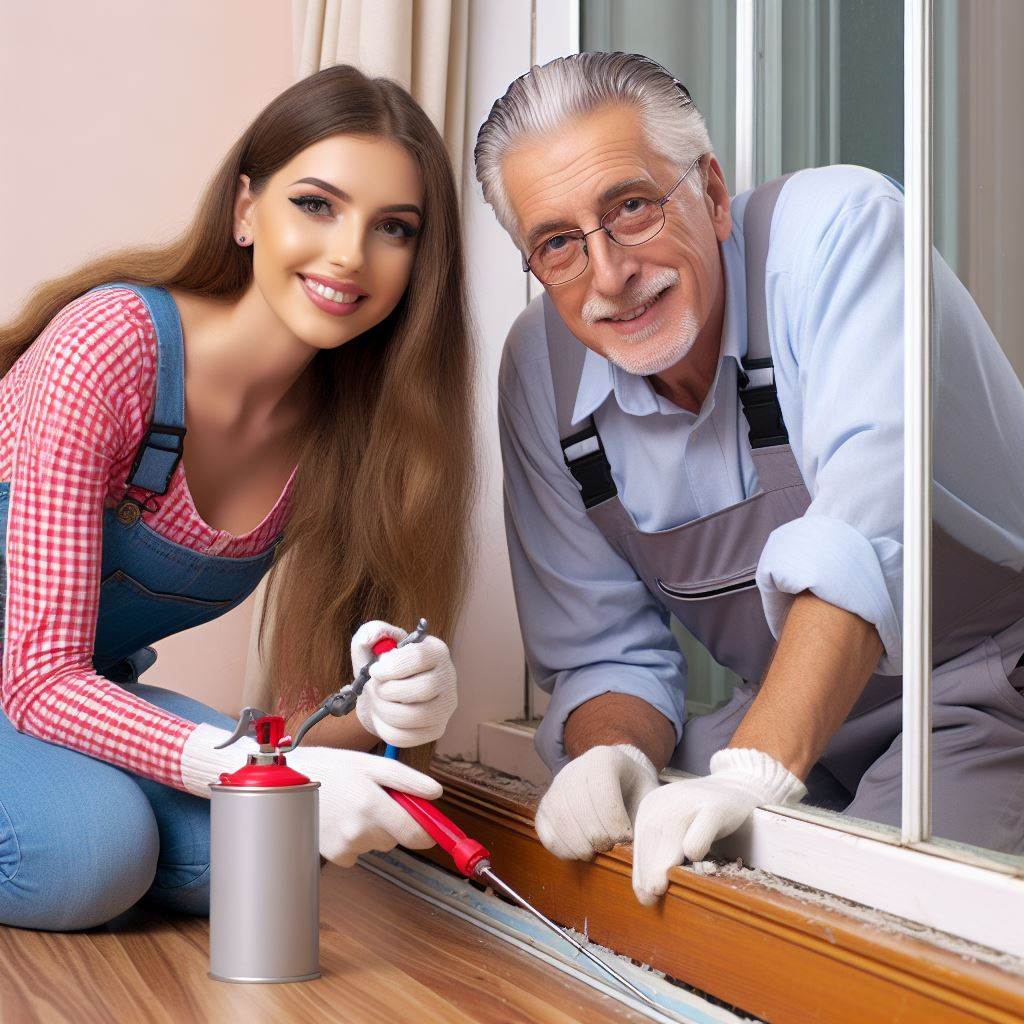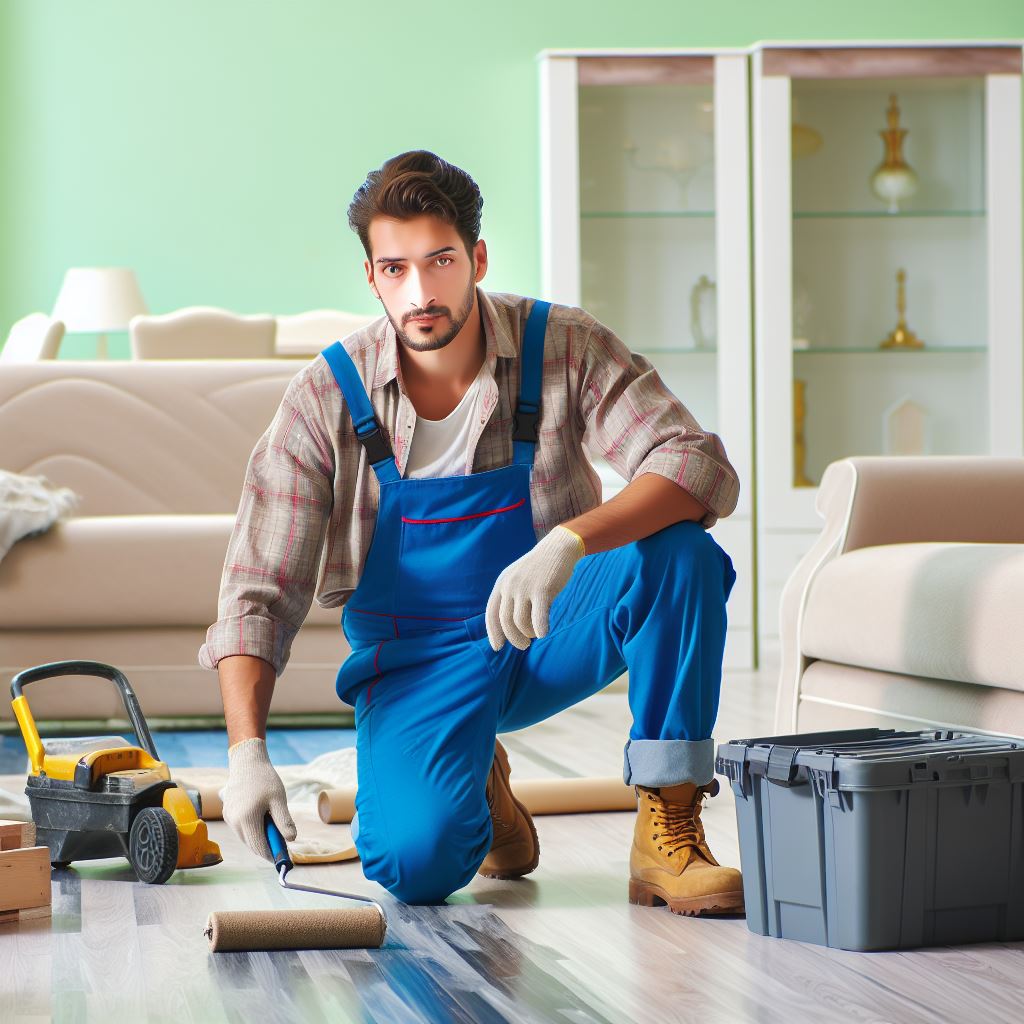Introduction
Flooring in rental properties serves as the foundation for daily activities, enduring constant wear and tear from tenants and visitors alike.
It withstands the weight of furniture, the scuffs of shoes, and the spills of various substances.
Neglecting its care can lead to costly repairs and replacements, diminishing the property’s appeal and value.
However, with proper maintenance and care, rental flooring can maintain its aesthetic appeal and structural integrity for years to come.
The purpose of this blog post is to delve into the intricacies of flooring care in rental properties, offering practical tips and strategies to landlords and property managers.
By highlighting the importance of proactive maintenance and providing actionable advice, this post aims to empower property owners to preserve their investment, enhance tenant satisfaction, and minimize expenses associated with flooring damage.
Whether you’re a seasoned landlord or a novice property manager, the insights shared here will equip you with the knowledge and tools necessary to prolong the lifespan of your rental flooring and create a more desirable living environment for your tenants.
Types of flooring commonly found in rentals
Choosing the right flooring for rental properties is crucial for both landlords and tenants.
Different types of flooring have their own advantages and disadvantages, so understanding their pros and cons is essential before making a decision.
Carpet
Carpet flooring is a popular choice for rentals because of its comfort and noise-reducing qualities.
However, it requires regular maintenance to keep it in good condition.
Pros and cons
Carpet provides warmth and insulation, making it a cozy option for rental properties. It also reduces noise, minimizing disturbances from tenants in other units.
On the downside, carpet stains easily and can trap allergens, requiring regular cleaning and maintenance.
Maintenance tips
To prolong the life of carpet flooring, vacuum regularly to remove dirt and dust.
Address spills and stains immediately with a carpet cleaner to prevent deeper stains from setting in.
Hardwood
Hardwood flooring adds a touch of elegance and value to rental properties. While it can be expensive to install, its durability and beauty make it a desirable choice.
Pros and cons
Hardwood floors are known for their durability and timeless aesthetic appeal. They can withstand heavy foot traffic and last for decades with proper care.
However, hardwood flooring can be susceptible to scratches and water damage.
Maintenance tips
Use rugs and furniture pads to protect hardwood floors from scratches.
Regularly clean the floors with a soft broom or mop to remove dirt and dust without causing any damage.
Laminate
Laminate flooring is a cost-effective alternative to hardwood, mimicking its appearance while offering easier installation and maintenance.
Pros and cons
Laminate is an affordable flooring option that comes in various styles, imitating the appearance of hardwood or tile.
It is easy to install and resistant to stains. However, laminate is susceptible to water damage and can be prone to scratches.
Maintenance tips
When cleaning laminate floors, avoid using excessive water that could seep into the seams and cause damage.
Quickly wipe up spills to prevent stains, and use a damp mop or cloth for regular cleaning.
Tile
Tile flooring is a durable and versatile option for rentals, especially in areas prone to moisture and high-traffic.
Pros and cons
Tile floors are highly durable and resistant to moisture, making them ideal for kitchens and bathrooms.
They are also easy to clean and maintain. However, tile can be cold and hard on the feet, requiring rugs or slippers for comfort.
Maintenance tips
Sweeping tile floors daily will prevent dirt and debris from scratching the surface.
Regular mopping with a mild cleaner will help maintain its shine and keep it looking its best.
Investing in proper flooring care is crucial for ensuring the longevity of rental properties.
By understanding the pros and cons of different types of flooring and following maintenance tips, landlords can make informed decisions and provide tenants with a comfortable and well-maintained living environment.
Read: Painting and Aesthetics: Maintenance for Appeal
General flooring care tips for rentals
Regular cleaning routines
Regular cleaning routines are the cornerstone of preserving flooring in rental properties.
By incorporating sweeping and mopping into your weekly or bi-weekly cleaning schedule, you effectively remove surface dirt and prevent it from accumulating over time.
This proactive approach not only enhances the appearance of the floors but also extends their longevity by minimizing abrasion and wear caused by gritty particles.
Vacuuming carpets complements sweeping and mopping efforts, especially in areas with carpeted flooring.
Regular vacuuming prevents dirt and debris from embedding deep into the carpet fibers, maintaining its plush appearance and preventing premature wear.
High-traffic areas may require more frequent vacuuming to effectively remove dirt and prevent matting.
Address spills and stains immediately
Spills and stains are inevitable in any living space, but prompt action can prevent them from causing permanent damage to flooring surfaces.
When spills occur, it’s crucial to act swiftly by blotting up liquids with a clean cloth or paper towel.
Avoid rubbing, as this can spread the spill and potentially damage the flooring material.
For stubborn stains, use a mild detergent solution and gently dab the affected area until the stain lifts.
Avoid using harsh chemicals or abrasive cleaners, as these can damage the finish or color of the flooring.
By addressing spills and stains promptly, you can maintain the pristine appearance of your rental’s floors and minimize the need for costly repairs or replacements.
Use area rugs and furniture pads
High-traffic areas and spaces prone to heavy furniture use can benefit from the strategic placement of area rugs and furniture pads.
Area rugs provide an extra layer of protection against wear and tear, especially in entryways, hallways, and living rooms.
Opt for durable, easy-to-clean rugs that complement your décor while safeguarding the underlying flooring.
Furniture pads placed under the legs of sofas, chairs, tables, and other heavy items distribute weight more evenly and prevent unsightly indentations or scratches on hardwood, laminate, or vinyl floors.
These inexpensive accessories are available in various sizes and materials, making them suitable for any type of furniture and flooring surface.
By using area rugs and furniture pads, you can minimize damage and prolong the lifespan of your rental’s floors.
Protection against scratches and dents
Furniture can inadvertently cause scratches and dents on flooring surfaces, particularly when items are moved or repositioned.
To mitigate this risk, consider using furniture coasters or felt pads under the legs or base of furniture pieces.
These protective accessories create a buffer between the furniture and the floor, reducing friction and preventing damage.
Additionally, implementing a no-shoes policy indoors can significantly reduce the likelihood of scratches on hardwood, laminate, or luxury vinyl plank flooring.
Outdoor footwear can track in abrasive particles like dirt, gravel, and sand, which can scratch or scuff delicate flooring surfaces.
By encouraging guests and household members to remove their shoes upon entering the home, you can preserve the integrity and appearance of your rental’s floors.
Preventative measures against moisture damage
Moisture is a common enemy of flooring materials, capable of causing warping, buckling, and mold growth if left unchecked.
Proper ventilation is essential for maintaining optimal humidity levels and preventing moisture buildup in the home.
Ensure that bathrooms, kitchens, and other moisture-prone areas are equipped with exhaust fans or windows to facilitate air circulation and moisture removal.
Additionally, placing doormats at entry points can help prevent moisture and dirt from being tracked indoors, minimizing the risk of water damage to flooring surfaces.
Invest in durable, absorbent doormats that effectively trap debris and moisture, preventing it from spreading throughout the home.
By implementing these preventative measures, you can safeguard your rental’s floors against moisture damage and maintain a healthy indoor environment.
In summary, proactive flooring care in rental properties involves a combination of regular cleaning routines, prompt spill management, and protective measures against scratches and moisture damage.
By following these guidelines and incorporating them into your maintenance routine, you can preserve the beauty and integrity of your rental’s floors for years to come.
Read: Tech Integration in Multi-Unit Properties
Flooring care specific to carpet
A well-maintained carpet can enhance the aesthetic appeal and longevity of your rental property. Here are some tips for caring for your carpet:
Regular vacuuming
Frequent vacuuming is essential to keep your carpet clean and free from dirt and debris.
Aim to vacuum at least once a week, focusing on high-traffic areas.
Professional deep cleaning
In addition to regular vacuuming, it is important to schedule professional deep cleaning for your carpets at least once a year.
This helps to remove stubborn stains and trapped dirt that regular vacuuming cannot eliminate.
Dealing with carpet stains
Stains on carpets are inevitable, especially in rental properties. Here are some techniques to effectively remove stains:
1. DIY stain removal techniques
For minor stains, you can try removing them yourself using household items such as dish soap, white vinegar, or baking soda.
Blot the stain gently, rather than rubbing, to prevent spreading.
Mix a solution of dish soap and warm water, and use a clean cloth to blot the stain until it disappears.
or stubborn stains, create a paste using baking soda and water. Apply the paste to the stain, let it sit for a few hours, then vacuum it up.
Another effective method is using a mixture of white vinegar and water. Spray the solution onto the stain, let it soak for a few minutes, then blot with a clean cloth.
2. When to seek professional help
While DIY techniques can work for minor stains, some stains may require professional assistance. Consider seeking professional help in the following situations:
- Deep, set-in stains that cannot be removed using DIY methods.
- Stains caused by substances like red wine, pet urine, or ink, which may require specialized treatment.
- Large areas with multiple stains that require extensive cleaning.
- If your attempts at stain removal are making the situation worse or causing damage to the carpet.
A professional carpet cleaning service has the knowledge, equipment, and chemicals to effectively remove tough stains and restore the carpet’s appearance.
By following these carpet care tips, you can maintain the longevity of your rental property’s flooring and leave a positive impression on your tenants.
Read: Appliance Maintenance: Extending Lifespan & Safety

Flooring care specific to hardwood
Sweeping and dry mopping
Regular sweeping and dry mopping are essential for maintaining the cleanliness and integrity of hardwood floors.
Using a soft-bristle broom or a dry mop, remove dust, dirt, and debris from the surface of the floor.
This simple routine prevents the accumulation of particles that can scratch the wood and cause long-term damage.
Proper use of cleaning products
When it comes to cleaning hardwood floors, it’s crucial to use products specifically designed for this type of flooring.
Avoid using harsh chemicals, abrasive cleansers, or excessive amounts of water, as they can harm the wood.
Instead, opt for pH-neutral cleaners that are safe for hardwood floors and follow the manufacturer’s instructions carefully.
Wood floor refinishing and maintenance
1. Signs it’s time for refinishing
Over time, hardwood floors may show signs of wear and tear, indicating the need for refinishing.
If you notice scratches, dullness, stains that can’t be removed, or the finish wearing off, it’s time to refinish.
Ignoring these signs can lead to further damage and potentially expensive repairs in the future.
2. Hiring professionals vs. DIY
Refinishing hardwood floors is a labor-intensive task that requires skill and expertise.
While some DIY enthusiasts may attempt this project, hiring professionals is often the better option.
Experienced flooring contractors have the necessary tools, knowledge, and experience to deliver outstanding results.
Additionally, they can recommend the most appropriate refinishing techniques and products for your specific floors.
Investing in professional refinishing ensures a durable and long-lasting finish, saving you time and money in the long run.
In fact, maintaining hardwood floors in rental properties requires proper care and attention.
Regular sweeping, dry mopping, and using appropriate cleaning products are vital for preserving the beauty of hardwood.
Recognizing the signs that refinishing is necessary and opting for professional services guarantee the longevity and aesthetics of the floors.
By following these tips, rental property owners can provide tenants with a clean and visually appealing living environment.
Read: Cloud Computing in Property Management
Flooring care specific to laminate
Achieving longevity in your rental property’s laminate flooring requires proper care and regular maintenance. Here are some essential tips:
Sweeping and dusting
- Regularly sweep or dust the laminate flooring to remove loose dirt, dust, and debris.
- Use a soft-bristle broom or a vacuum cleaner with a brush attachment to avoid scratching the surface.
- Consider using a microfiber dust mop for quick and efficient cleaning.
Damp mopping
- For more thorough cleaning, damp mop the laminate flooring with a well-wrung mop.
- Avoid excessive moisture and never allow standing water on the floor, as it can damage the laminate.
- Use a mild laminate floor cleaner or a mixture of vinegar and water for effective cleaning.
- Follow the manufacturer’s instructions on cleaning products to avoid any potential damage.
Protecting against scratches
- Place doormats at entryways and encourage tenants to wipe their feet before entering to prevent dirt and debris from scratching the laminate.
- Consider using furniture pads or felt protectors under the legs of chairs, tables, and other furniture to avoid scratching the floor.
- Avoid dragging heavy objects across the laminate, as it can cause irreversible damage.
Repairing damaged laminate
- Periodically inspect the laminate flooring for any signs of damage or wear.
- Address minor scratches or chips by using a laminate repair kit or colored wax crayon that matches the floor’s color.
- For larger damages, consult a professional flooring contractor to repair or replace the affected area.
By following these tips, you can effectively maintain the laminate flooring in your rental property, ensuring its longevity and minimizing expensive repairs or replacements.
Flooring care specific to tile
A well-maintained tile floor can add beauty and durability to your rental property. Here are some tips to ensure the longevity of your tile flooring:
Regular sweeping and mopping
Keeping your tile floors clean is essential for their longevity. Regularly sweep or vacuum the floors to remove loose dirt and debris.
Follow up with mopping using a mild floor cleaner and warm water.
Tile and grout cleaning
Over time, tiles can accumulate dirt, stains, and grime, affecting their appearance.
Regular cleaning of both tile surfaces and grout lines is crucial for maintaining their beauty. Here are some options for cleaning:
1. DIY methods
You can clean tile and grout using simple household items. For general cleaning, make a solution of equal parts vinegar and water.
Apply the solution to the tiles and grout lines, scrub gently with a soft brush, and rinse with clean water.
For stubborn stains or grime, you can create a paste using baking soda and water.
Apply the paste to the affected areas, let it sit for a few minutes, scrub, and rinse thoroughly.
2. Professional cleaning options
If you prefer a more thorough and efficient cleaning, consider hiring professional tile and grout cleaning services.
Professionals have the expertise and specialized equipment to deep clean and restore the appearance of your tile floors.
Preventing and repairing tile damage
To maintain the longevity of your tile flooring, it’s essential to prevent and promptly address any damage. Here are some tips:
- Place doormats at all entrances to trap dirt and prevent scratching on the tiles.
- Use coasters under furniture legs to avoid scratching or cracking the tiles.
- Avoid using harsh chemicals or abrasive cleaners that can damage the tiles or grout.
- Regularly inspect the tile floor for cracks, loose tiles, or grout deterioration.
- If you notice any damage, arrange for repairs as soon as possible to prevent further deterioration and potential accidents.
In general, proper care and maintenance of your tile flooring can significantly impact its longevity in rental properties.
Regular cleaning, both through DIY methods and professional cleaning, is important for preserving the beauty of the tiles and grout.
Additionally, taking preventive measures and promptly addressing any damage can help prolong the lifespan of your tile floors.
Conclusion
Let’s quickly revisit the core principles we’ve discussed regarding flooring care.
Consistent and thorough cleaning, coupled with proactive maintenance routines, stand as the cornerstone for preserving the integrity and appearance of any flooring type within rental properties.
Whether it’s vacuuming carpets regularly to prevent dirt buildup or using gentle cleaners and techniques to maintain the shine of hardwood or laminate floors, these simple actions can significantly extend the life of your flooring investment.
It cannot be overstated: ongoing maintenance is paramount for ensuring the longevity of flooring in rental units.
Beyond just aesthetics, well-maintained floors contribute to the overall safety and comfort of tenants, reducing the likelihood of slips, trips, and other accidents.
By addressing issues promptly, landlords can mitigate the need for costly repairs or replacements down the line, ultimately saving time, money, and hassle in the long run.
Lastly, we want to emphasize the shared responsibility between landlords and tenants in upholding proper flooring care practices.
While landlords should provide guidance and support by implementing preventive measures and conducting regular inspections, tenants play a crucial role in day-to-day maintenance and reporting any issues promptly.
By fostering open communication and a mutual commitment to caring for the property, both parties can enjoy the benefits of a well-maintained living space, fostering a positive rental experience for everyone involved.
Prioritizing flooring care isn’t just about preserving aesthetics; it’s about investing in the long-term value and functionality of rental properties.
By adhering to these key principles and working together, landlords and tenants can ensure that floors not only look great but also stand the test of time, enhancing the overall quality of rental accommodations.




